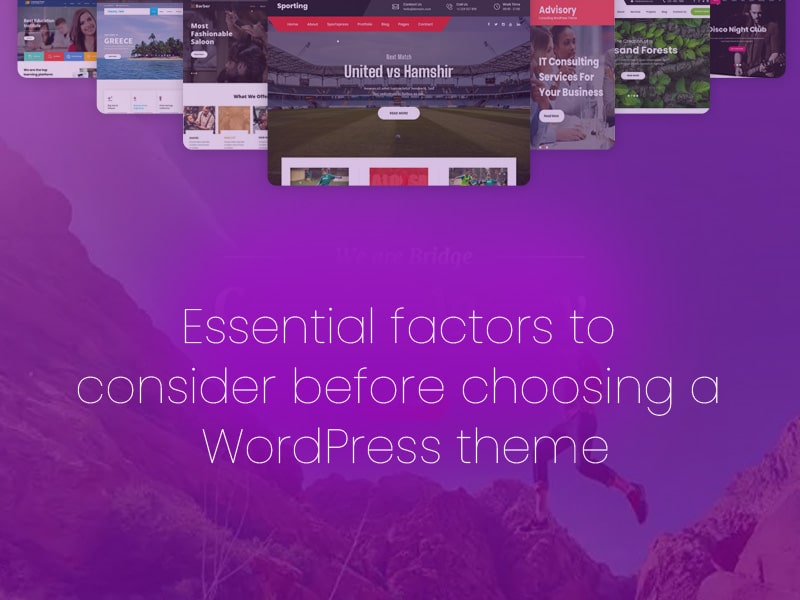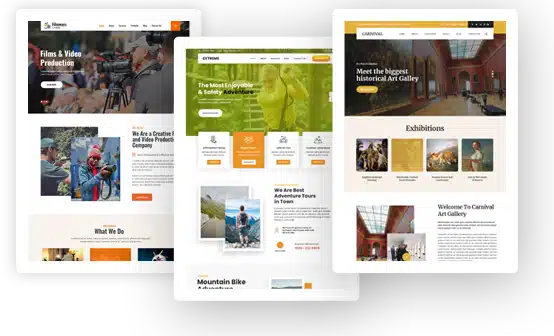Essential factors to consider before choosing a WordPress theme

WordPress has had a major impact on the digital marketing industry in the last decade. It’s easy to construct responsive websites using the platform’s straightforward content management system. The apparent limitless collection of themes and plugins adds to its potential.
Using a content management system (CMS) enables people or organisations of any skill level to submit material to their website coveniently and quickly. This strategy takes no coding or technical abilities at all. 65.2 per cent of the websites that we know utilise WordPress. It is equivalent to 42.5% of all web pages.
40% of the internet’s content is powered by WordPress in 2021, up from 35% in 2020 and 4% over last year. WordPress accounts for 64.1% of all CMS-built sites, an increase of 4% from 2020.
What is a WordPress theme?
Your website’s layout and style can be changed using a WordPress theme. In addition to design, font, and colour, themes allow you to personalise your site’s look. A WordPress theme is a zipped folder containing a collection of files, including a set of PHP page templates and CSS stylesheets.
Whenever you initially set up a WordPress site, it comes with a pre-installed default theme. Using WordPress, you may customise the look and feel to suit your needs and sector. When you choose the appropriate theme, you’ll make your website more visually appealing, easier to use and more engaging for visitors.
Finding a theme for your website might be daunting if you’re new to WordPress. When there are hundreds of options, it may be not easy to know where to start. However, choosing a WordPress theme is amongst the crucial decisions you’ll make throughout website creation, and it may have a huge influence on the effectiveness of your website.
Losses in traffic and conversions will result if you choose the wrong theme, so be careful. Switching themes without the aid of a WordPress developer may also be tough. But with the help of a website designing agency, this matter can also be solved easily.
Most popular WordPress themes
Your WordPress theme is one of the first things you should consider while creating your website. A good theme should include the style and functionality you need but also be regularly updated and maintained.
Some of the greatest and most prominent WordPress themes are:
- Divi: It is a multi-purpose theme offered by Elegant Themes. The notable feature of this theme is that it is customised with a drag-and-drop builder.
- Genesis: Child themes can be used to customise the theme structure.
- Astra: Pre-designed templates in this theme make it easy to get started with a customised theme.
- Ocean WP: One of the easiest themes to use for novices, it’s lightweight, customisable, and free.
There are dozens of gorgeous layouts in each of these themes, and they are all flexible and highly maintained. Additionally, they’re all regarded to be multi-functional templates that may be used on a wide variety of websites. Your blogs, corporate sites, eCommerce sites and more can benefit from them.
Factors to consider before choosing WordPress themes
Bear in view that each WordPress theme is compatible with a certain target market. Using a systematic approach of shortlisting and selecting the most suitable theme is the best way to start. In every checklist, these are the several key aspects that should be considered.
Browser compatibility
Google Chrome is the most utilised web browser in the world. According to Statcounter, Google Chrome has a market share of more than 60 per cent. It’s no wonder that several WordPress Website designers and web admins test a theme on Chrome but forget to check compatibility with the other major browsers such as Safari. Mozilla, Microsoft Edge, and UC Browser.
Nevertheless, it’s vital to understand that the other browsers’ market share of roughly 40% is significant. There is a broad variation in the popularity of browsers based on geographic area, age group and economic level. There is a good chance that the bulk of your target market uses a browser for which you did not test a theme.
Most themes support all mainstream browsers; however, you may use basic automated tools online to verify that if that isn’t expressly stated on the page.
Customisation
A theme’s default layout is unlikely to meet your demands perfectly, which is why your theme must be customisable to suit your requirements.
Although all themes may be customised to some level, having few options will severely limit your potential to trademark and improve the user experience. While having too many options can cause your site to load slowly and become unresponsive for users. It’s worth checking out the theme listing’s customised demo to see whether it’s possible to update page components and customise the appearance to fit your own brand.
If you intend to add an element or modify your layout, you shouldn’t need PHP for Dummies. A drag-and-drop page builder plugin like Divi or Elementor may help you make these changes quickly. It allows you to change themes while still using the same builder.
Visuals
Let’s talk about what WordPress themes have always been about: the appearance and feel. Before anything else, you want your website’s theme to visually match the content of your site, which should be convenient to use and understand.
Depending on your business’s type, you probably have a clear idea of your brand and how you would like your website’s page to appear to visitors. Different WordPress themes will be required based on the type of blog. A culinary blog will need a unique theme complementing the main brand image, similarly for an online clothing store and a real estate agent’s website.
Examine the websites of other companies in your sector if you’re not confident about the look. Find out which theme your favourite sites are utilising if they’re created using WordPress.
Many themes include a lot of dazzling animations, complicated layouts, and bright hues to make them appealing. Nothing is improper with these things, and you may even need them to design a site that matches your goals in some situations. But for the most part, these are just extras that can make it difficult to evaluate the theme’s essential functionality.
It goes without saying that when it comes to anything, simplicity is a virtue. Choose a theme first and foremost for its capacity to aid the achievement of your site’s goals. Elegant websites can attract visitors, but they won’t return or suggest your site to their peers if they can’t use it or navigate it. The theme should be simple on the eyes yet not overly complex.
SEO friendliness
Most of the traffic to your WordPress websites will originate from Google Search and, to a limited extent, Bing if your blog is like the vast majority of active websites on the internet. Search engine optimisation (SEO) is therefore essential.
Not all themes are optimised for search engine optimisation. If your site’s search engine results ranking is negatively affected by a theme’s HTML coding, it might be a turn-off for your visitors. WordPress website owners can’t analyse a theme for SEO compliance on their own. For the most part, premium theme developers will give a brief checklist of the SEO aspects that their theme has already been optimised for. Or you can check these techniques to boost your WordPress website’s SEO.
Plugin support
If you intend to do more than the fundamental blogging functions of WordPress core, you’ll need to use plugins. Most of all, the WordPress plugins that you want to utilise for social sharing, contact forms, eCommerce functionality, and sophisticated SEO optimisation must be completely compatible with your theme’s codebase.
Any theme worth the name will have this covered. As an alternative, if you’re looking at any lesser-known themes, make sure that they function with popular plugins. If it doesn’t, it’s preferable to find an alternative.
Customer support
There are millions of free WordPress themes available on the internet. When you choose a free theme, you’ll have to deal with unreliable support. The customer service for some of the premium themes is also mediocre, which is a shame.
A lack of theme support might leave you stranded when you encounter setup issues. In the case of an individual-owned site or a new website, the cost of constantly calling a third-party developer might be unreasonably high. A WordPress theme with solid support and extensive documentation is a must-have.
Several months of premium customer assistance is included with most purchased WordPress themes. Then you’ll have the option of renewing it either monthly or annually. When choosing a theme, consider the expense of a monthly support subscription if you plan on utilising its benefit in the future.
It’s important to remember that free themes don’t always come with the same level of support that paid themes do. As a result, you’re on your own if you run into any serious issues.
Performance
The loading speed of a page has a direct influence on SEO. It has been shown that faster load times result in better search engine results as well as greater visitor conversions and engagement. Why? Because of the impatience of Internet users. Today, the benchmark for websites is an average load speed of under three seconds; however, this will differ depending on the quantity of material each page has.

